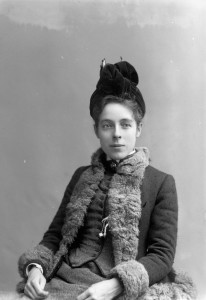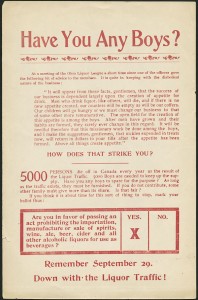7.5 Women’s Organizations and Reform
Melanie Buddle, Department of History, Trent University

Beginning in the 1870s, a number of women’s organizations and clubs formed locally, nationally, and internationally. Some, such as the Young Women’s Christian Association (YWCA), which opened a Canadian branch in 1870, the Women’s Christian Temperance Union (WCTU), which opened its first Canadian branch in 1874, and the National Council of Women of Canada (NCWC), which formed in 1893, were Canadian affiliates of international women’s organizations. These and other women’s groups formed during a period of huge social upheaval. At the end of the 19th century, industrialization, urbanization, and increased immigration led some women to take public action against social ills that seemed to threaten traditional family life. They felt that the way to protect women and children was to protest the evils of alcohol and attendant evils, such as prostitution, poverty, and poor working conditions amongst the lower classes. The WCTU campaigned first and foremost for temperance (limiting the use of alcohol and encouraging sobriety) and prohibition (laws to ban alcohol entirely) because they blamed alcohol for social problems, such as poverty, immorality, and prostitution. Other groups had different mandates (education, working conditions for women, and philanthropy), but addressed the same social ills.
Inside meetings of literary clubs, temperance societies, and Christian associations, women critiqued the political and educational limitations of womanhood but were careful to maintain the conventions of their time. Many maintained a mandate to support families, children, and womanly arts, and praised the conventional roles of women. This was an effective strategy, as it was not particularly threatening to Canadian society at the time: men voted and worked, and women were responsible for children and domestic labour — although this was changing as more women were joining the paid labour force.
The WCTU shared features with other women’s groups that formed during this period: a focus on Christian values and on protecting women, children, and the less fortunate. These ideals formed what historians call the “Social Gospel”: a Christian-influenced approach that brought an evangelical fervour to public reform (see Section 7.6).[1] Emerging women’s clubs shared another feature: a growing commitment to a larger public and political role for women, including steps toward women’s voting rights. Some were more tentative than others in moving toward women’s rights to the vote (suffrage) but by the early 1900s many discussed it. These groups provided a discursive space for women to talk about issues ranging from education, temperance, domestic arts and social reform, to arts and crafts and literature — and sometimes, female suffrage.
The NCWC, a national umbrella organization for women’s groups, formed 20 years after the WCTU arrived in Canada, and became an affiliate of the International Council of Women. Led by Lady Aberdeen (1857-1939), wife of the Governor General, its first member was the Women’s Art Association of Canada. Adelaide Hoodless (1857-1910), a prominent social reformer who would be influential in the Canadian YWCA, co-founded the NCWC. The NCWC had a mandate to improve the status of women, and social conditions for women and children, but initially stopped short of supporting female suffrage. Interestingly, the WCTU influenced its formation but refused to join because the NCWC was not religious enough. Yet in 1888, the WCTU was the first large women’s group to specifically support suffrage. The NCWC did not specifically endorse women’s rights to vote until 1910, and many of their member organizations, including some of the local Councils of Women across the country, did not endorse, and even opposed, women’s suffrage.[2] Thus we see a mix of radicalism and conservatism in many early women’s groups.
Other women’s organizations appeared in this fertile period. On the surface, national and local women’s groups such as the Canadian Women’s Press Club (1904), the Women’s Art Association of Canada (1892), the YWCA (1870; Canada-wide in 1893), the Imperial Order Daughters of the Empire (IODE, 1900), and the Toronto Women’s Literary Club (1876) appeared devoted to artistic, educational, and professional or business pursuits. Many promoted service to girls and women, such as the YWCA, which emphasized the temporal, religious, and moral welfare of young women.[3] But even outwardly more conservative groups such as the IODE (which resisted suffrage and focused on patriotism, education and philanthropy) could become vehicles of social and political change. The Toronto Literary Club was the first to publicly move in this direction, changing its name to the Canadian Women’s Suffrage Association, and becoming the first Canadian group with suffrage as its main aim.[4] Clubs could be screens for political action, and supporters of female suffrage were inevitably involved in one or more of the other women’s organizations, even those that did not focus on suffrage. The Canadian Women’s Press Club included female novelists, newspaper editors, and reporters and its early members included Nellie McClung (1873-1951) and Emily Murphy (1868-1933), who were prominent social reformers and suffragists. And the very fact that women were organizing and reaching out in a public way, regardless of the professed mandate or cause, was in itself a radical move for women.
While working-class women also organized and protested the inequity of society, the most prominent female reformers in the late 1800s and early 1900s were white middle- and upper-class women. Their approach to social issues seemed to blame the “fallen women” and less fortunate: reformers attempted to preserve a fading Victorian middle-class family life and their identification of the problem was sometimes the fallen themselves, rather than industrial, economic, and related societal upheavals. Some of the same women supporting female suffrage and social reform also supported eugenics (see Section 7.8), limiting immigration of non-whites, and extending the vote only to white women, due to a fear of “racial degeneration.”[5] Others, like Hoodless, opposed female suffrage; she argued that women should exercise their influence through their sons and husbands.[6]
By association, by marriage, by family status, and by community prominence, these women had time and energy for art associations, moral reform campaigns, temperance groups, and art clubs. We can acknowledge their efforts to provide aid and to give women more power through public life, and we can acknowledge that compared to men, they were treated unequally and were subject to discrimination. But these same women had a degree of privilege not afforded to non-white and lower-class women in Canada. They were also divided in their support for a more political role. Some women, and some groups, opposed suffrage or focused only on moral or spiritual issues. Some focused on domestic science and handicrafts but moved toward suffrage, and others specifically supported suffrage as the key to relieving other social ills.
Early supporters of female suffrage have been called maternal feminists because they argued that their role as mothers and homemakers, as “angels of the house,” was the reason they needed more influence in society — and not, as later feminists would argue, because they ought to be treated as equal to men.[7] Women’s clubs were pivotal in that they were early opportunities for women to discuss the increasingly public roles they could play in society. We cannot dismiss them only as social gatherings for ladies of privilege, because they also led to important conversations about women’s rights in society and in the political and professional realms. These groups were more radical in their context than they might appear to us, looking backward. Despite the grounding of many clubs in a narrow ideology of white women’s rights, mother’s rights, and Social Gospel “purity” arguments, they paved the way for women like Agnes Macphail (1890-1954), Canada’s first female member of parliament. Macphail, in 1925 said: “I do not want to be the angel of any home, I want for myself what I want for other women, absolute equality. After that is secured then men and women can take turns at being angels.”[8]

Key Points
- The 1870s witnessed the creation of important and influential women’s organizations; more followed before 1914.
- Many of these organizations shared a strong Christian orientation and concern regarding social ills, including the social and domestic consequences of alcohol abuse.
- These organizations provided a springboard for female activism, early feminism, and demand for greater female rights (including the right to vote).
- Opposition to the franchise remained an important force in women’s organizations.
- Overwhelmingly, these were middle- and upper-class organizations representing white women with extensive privilege and social and cultural capital. Many were, as well, highly radical in their context.
Attributions
Figure 7.4
Miss Bertha Wright (later Mrs. Carr-Harris, first President of the Canadian Young Women’s Christian Association) (Online MIKAN no.3229086) by William James Topley / Library and Archives Canada / PA-167608 is in the public domain.
Figure 7.5
Have You Any Boys? : Remember September 29, Down with the Liquor Traffic! (Online MIKAN no. 2988523) by Library and Archives Canada, Acc. No. 1984-4-943 W.C.T.U Dominion is in the public domain.
- See Mariana Valverde, The Age of Light, Soap, and Water: Moral Reform in English Canada, 1885-1925 (Toronto: McClelland and Stewart, 1991). ↵
- Katja Thieme, “Language and Social Change: The Canadian Movement for Women’s Suffrage, 1880-1918” (PhD Thesis, University of British Columbia, 2007), 31. ↵
- Toronto YWCA, Constitution of the Toronto YWCA, 1873, Article II, cited in Mary Quayle Innis, Unfold the Years: A History of the YWCA in Canada (Toronto: McClelland and Stewart, 1949), 13. ↵
- Alison Prentice et. al., Canadian Women: A History, 2nd Edition (Scarborough: Thomson Nelson, 2004), 195-196. ↵
- See Anne-Maria Kinahan, “Transcendent Citizenship: Suffrage, the National Council of Women of Canada, and the Politics of Organized Womanhood,” Journal of Canadian Studies 42, 3 (2008): 5-27. ↵
- Terry Crowley, “HUNTER, ADELAIDE SOPHIA [HOODLESS],” in Dictionary of Canadian Biography, vol. 13, University of Toronto/Université Laval, 2003–, accessed 22 September 2015, http://www.biographi.ca/en/bio/hunter_adelaide_sophia_13E.html. ↵
- Thieme, “Language and Social Change”, 15-16. ↵
- Canada, House of Commons, Debates, 26 February 1925. ↵

